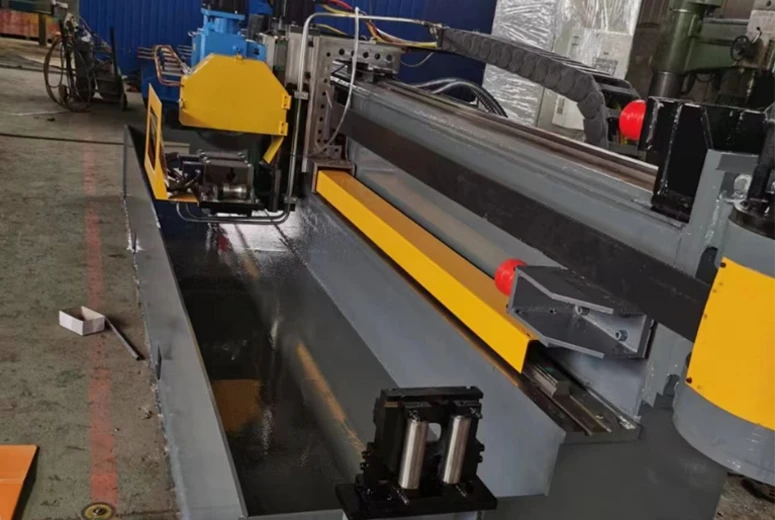plate straightening machine
The Importance of Plate Straightening Machines in Modern Manufacturing
In the ever-evolving landscape of manufacturing, precision and quality control are paramount. One of the significant innovations that have emerged to enhance these aspects is the plate straightening machine. These machines play a crucial role in the fabrication and assembly processes, ensuring that metal plates are correctly aligned and free from deformation. This article aims to explore the functionality, benefits, and applications of plate straightening machines in modern industry.
Understanding Plate Straightening Machines
A plate straightening machine is designed to correct the warping and bending that often occurs in metal plates during various fabrication processes. Steel, aluminum, and other metals can become deformed due to thermal expansion, machining operations, or improper handling. The straightening process uses specific mechanical arrangements to apply force to a plate, gradually adjusting its shape back to the desired specifications.
These machines vary in design based on the type of material being processed and the specific requirements of the manufacturing operation. Standard configurations may include hydraulic, pneumatic, or mechanical systems, which can be adjusted to suit different plate sizes and thicknesses.
The Functionality of Plate Straightening Machines
The primary function of plate straightening machines is to ensure that metal plates meet the strict standards required for downstream applications. The process begins with the loading of a deformed plate into the machine, where it is secured in place. Through a combination of rollers, hydraulic cylinders, and various pressure controls, the machine effectively applies force to strategic points on the plate.
As the machine operates, it monitors the real-time deformation and applies corrective pressure, gradually restoring the plate to its original shape. Many modern machines are equipped with advanced sensors and digital interfaces, allowing for automated adjustments and precise control. This enhanced functionality minimizes the risk of damage during the straightening process and maximizes efficiency.
plate straightening machine

Benefits of Using Plate Straightening Machines
1. Increased Precision One of the most significant advantages of employing a plate straightening machine is the level of precision it offers. Manual straightening methods can lead to inconsistencies and misalignment, while machine-assisted processes ensure that tolerances are met with high accuracy.
2. Time Efficiency Straightening metal plates manually can be a labor-intensive task, consuming valuable production time. By utilizing automated straightening machines, manufacturers can significantly reduce processing times, allowing them to focus on other critical aspects of production.
3. Cost Reduction By preventing damage to plates and reducing the frequency of rework or scrap, plate straightening machines can lead to substantial cost savings. The initial investment in such machines is often offset by the long-term benefits realized in productivity and reduced material waste.
4. Improved Quality Control Quality assurance is a vital part of the manufacturing process. Using plate straightening machines enhances overall product quality, reducing the likelihood of defects that could arise from improperly aligned plates. This improvement contributes to better end products that meet customer specifications.
Applications Across Industries
Plate straightening machines are commonly used in various industries, including automotive, aerospace, construction, and heavy machinery manufacturing. In the automotive sector, for example, these machines are essential for preparing components such as chassis and body panels. In aerospace, precision alignment is crucial for safety, making straightening machines vital for aircraft component fabrication.
In conclusion, plate straightening machines offer a blend of accuracy, efficiency, and cost-effectiveness that is indispensable in today’s manufacturing environment. As industries continue to demand higher quality standards and faster production times, the role of these machines will only grow in significance. By embracing such technology, manufacturers can ensure they remain competitive in an increasingly rigorous market landscape.
-
High Frequency Straight Seam Welded Pipe Production Line-BzZhou Xinghua Machinery Equipment Manufacturing Co., LTD.|line pipe steel&welded gas pipeNewsJul.30,2025
-
High Frequency Straight Seam Welded Pipe Production Line-BzZhou Xinghua Machinery Equipment Manufacturing Co., LTD.|High Precision&Automated SolutionsNewsJul.30,2025
-
High Frequency Straight Seam Welded Pipe Production Line - BzZhou Xinghua Machinery Equipment Manufacturing Co., Ltd.NewsJul.30,2025
-
High Frequency Straight Seam Welded Pipe Production Line-BzZhou Xinghua Machinery Equipment Manufacturing Co., LTD.|Precision Welding, High EfficiencyNewsJul.30,2025
-
High Frequency Straight Seam Welded Pipe Production Line|BzZhou Xinghua|Precision Welding&EfficiencyNewsJul.30,2025
-
High Frequency Straight Seam Welded Pipe Production Line - BzZhou Xinghua|Precision Engineering&EfficiencyNewsJul.30,2025


